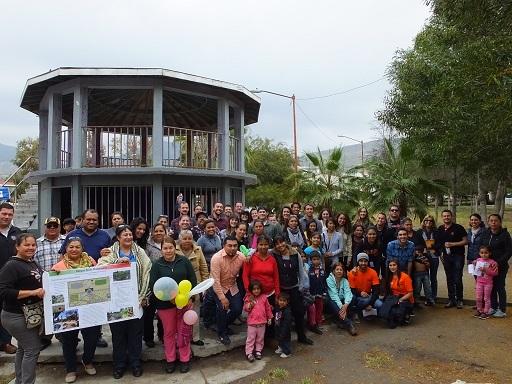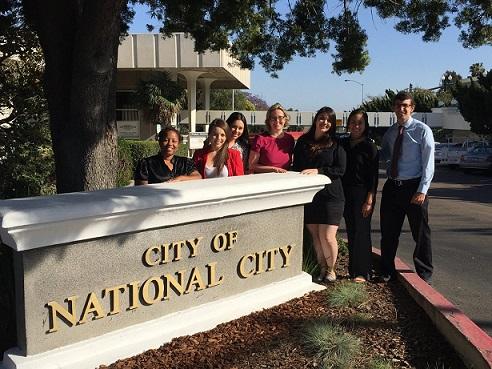Universities Lend a Hand with Sustainability
Published October 13, 2016
This article is part of a series about EPA's Net Zero program.
Projects that enhance local sustainability, reduce energy use, and conserve water are incredibly important for the health of cities, but sometimes, city governments don’t have the time or resources to launch these efforts. That’s why EPA and partners are helping cities leverage the skills and expertise of local universities to achieve sustainability goals.
EPA is connecting with cities and universities through Educational Partnerships for Innovation in Communities (EPIC) programs. Through an EPIC program, a city government identifies several sustainability related projects that are matched with existing courses at a local university, and then faculty and students from that university complete the projects as part of their coursework.
The partnerships formed through the program has the double benefit of improving the city’s environmental health while also giving students an opportunity to apply what they’ve learned in class to real world problems.
The EPIC framework was created by the University of Oregon in 2009 as a vehicle to apply the diverse experience of a university to the environmental, economic, and social problems of cities. University faculty began training others on the model; and in 2015, along with early adopters of the framework, formed the EPIC Network to support expansion on a national and international level. San Diego State University geography students presented their proposed designs for the Ejido Matamoros park in Tijuana to community members who had the opportunity to provide their feedback on the designs.
San Diego State University geography students presented their proposed designs for the Ejido Matamoros park in Tijuana to community members who had the opportunity to provide their feedback on the designs.
Under EPA’s Net Zero Initiative, an effort that aims to support communities and the military in achieving goals of net zero energy, net zero waste and net zero water, EPA has contracted the creators of EPIC to help universities and local governments across the country launch partnerships where EPA tools and strategies can be used in real-world projects.
Successful collaborations have led to more than 25 universities in a dozen different states participating in these campus-community partnerships. That’s thousands of students committing their time and energy to solving environmental, social, and economic problems.
Students from the University of Minnesota, for example, have worked with nearby cities such as Minnetonka conducting audits on stormwater regulations. Over in California, students from San Diego University have also completed several partnerships, including one with National City where engineering students helped redesign a three block area of a street to reduce traffic flow and strengthen drought tolerance.
“In some cases, the city is specifically asking for research. They want numbers and cross-benefit analyses that can help them make decisions,” says Jessica Barlow, director of San Diego State University’s EPIC program, the Sage Project. “In other cases, they actually implement something that the students recommend or they use what the students have designed to move a project forward in another way.”
 San Diego State University speech, language, and hearing sciences students pose in front of City Hall in National City, CA after presenting the work they did with National City seniors to the Parks, Recreation, & Senior Citizen Advisory Board.Partnerships can also have the added benefit of motivating people on the city side. Brad Raulston, National City’s executive director of community development and planning, was surprised at how much of a difference the youthful energy of students made to the projects. “A lot of government workers initially thought that this was just a program to give students experience with a real-world setting, but they quickly came to appreciate their perspectives and enthusiasm.”
San Diego State University speech, language, and hearing sciences students pose in front of City Hall in National City, CA after presenting the work they did with National City seniors to the Parks, Recreation, & Senior Citizen Advisory Board.Partnerships can also have the added benefit of motivating people on the city side. Brad Raulston, National City’s executive director of community development and planning, was surprised at how much of a difference the youthful energy of students made to the projects. “A lot of government workers initially thought that this was just a program to give students experience with a real-world setting, but they quickly came to appreciate their perspectives and enthusiasm.”
EPA is supporting these campus-community sustainability partnerships by funding informational workshops and providing access to EPA tools and laboratories. Just last year, EPA’s regional office for the Pacific Southwest (EPA Region Nine) brought 76 representatives from government, university, and industry together to discuss Net Zero energy/waste/water strategies and the advantages of such partnerships. At that same workshop, EPA took the time to meet with universities and local governments interested in starting their own programs.
“EPA has been a great help to the Sage Project,” says Barlow. “One of the biggest challenges we have is just getting heard. EPA can reach state, national, and international audiences. For example, the Sage Project is working with Tijuana, a city just across the border to improve quality, safety, accessibility, and environmental sustainability of green spaces. We could have only made contact with EPA support.”
EPA is currently working with California State University (CSU) Chico, CSU Fresno, and CSU Sonoma to incorporate the EnviroAtlas, an EPA interactive mapping tool that shows the links between the ecosystem and human health, in their projects with local cities. EPA is also helping other universities like CSU Monterey Bay and CSU East Bay use such EPA tools in projects concerning community health and food/health education.
While EPA researchers can help partnerships by sharing strategies, tools, and agendas, more assistance is needed to advance sustainability in communities. That’s why they are actively working to include their federal partners (such as the US Departments of Health and Human Services, Housing and Urban Development, Transportation, Agriculture, and Energy) as well as industry and other potentially interested stakeholders in the EPIC Network. These partnerships can be more effective if supported by multiple agencies and organizations.
By promoting the EPIC framework, EPA hopes to accelerate the adoption of new policies and strategies, motivate city staff in their project work and train the next generation to solve sustainability issues.
Learn more:
- EPA’s Net Zero
- Net Zero Partnerships
- EPA’s Region 9
- EnviroAtlas
- EPIC Framework (3 Minute Video)
- EPIC-N
